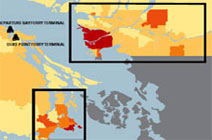British Columbian homeowners are often reminded that well-built wood frame houses tend to do well in earthquakes. This is no doubt reassuring, especially when major quakes are striking regularly around the Pacific coast.
What may not be so well considered is that “well-built” is a relative term. The average car, for example, is well built for the purpose of transporting passengers along paved roadways. Subjected to extreme off-road conditions, it will probably break down.
Similarly, the average B.C. home, well built to the standard of the day, is likely to survive a good long time under typical conditions, even some atypical, such as a fairly moderate shaker. Subjected to moderately strong, not even extreme seismic conditions, however, they are susceptible to structural failures.
To shed some perspective on the risk, California’s Northridge earthquake caused $12.5 billion in residential damage, about 60% of that to houses. Fifteen ghost towns were created where 40% to 90% of the residential units were rendered uninhabitable. Including apartment dwellers, 125,000 were left temporarily homeless. At magnitude 6.7, it is only a moderate earthquake.
The worst damage to wood-framed buildings was, in every instance, caused by a similar set of structural weaknesses.
The first point of failure in houses was at the perimeter walls beneath the main floor. Sitting on the foundation, they support the weight of the house. Their weakness lay in the amount of lateral stress they could withstand. A strong earthquake easily exerts several tons of horizontal force, beyond the capacity of most homes’ supporting walls. Unbraced, they collapsed like dominos precipitating a chain reaction of failures.
Garage walls also gave way, coming to rest at a precarious angle or collapsing altogether under second story weight. With only three walls, they were at a distinct seismic disadvantage, as were buildings with failed tuck-under parking.
In the end analysis, it all could have been prevented rather easily. That was 20 years ago. Seismic strengthening has become as common a home improvement as exterior painting and reroofing in the Pacific States. Where, in heaven’s name, is the concern up here?
B.C.’s seismic code guidelines were introduced late December, 2012. Therefore, it follows that unless engineer-designed to seismic standards, homes built prior are potentially vulnerable.
Homeowners need to know about reinforcements that will strengthen their homes dramatically, protecting them from crippling insurance deductibles and needless hardship.
They need to know that properly braced basement and garage walls will keep their homes upright; bolts will keep them in place. And, that existing bolts may or may not be reliable, depending how they were installed; they might need extra.
Worse, numerous 1980’s to early 1990’s homes on the Mainland, and possibly on the Islands, are without bolts at all. They were replaced with a light metal “Tidy Tie” strap believed to have been approved by the Building and Safety Standards Branch. They, and primitive knock-offs, have no seismic strength.
Additionally, they need to know that the connection of the floor to the braced walls needs to be strengthened so the house cannot slide off. Where the floor sits directly on the foundation, this joists to sill plate (the piece of wood through which foundation bolts are installed) is reinforced.
These are the primary components of a typical home strengthening but certainly not all, and the details vary. Even a basic understanding of the problems and solutions will allow owners to make educated decisions about how best top protect the occupants and their property investments.
Earthquake insurance, while prudent, is not the magical answer to all. It will not prevent injury while their house is vibrating violently back and forth. It will not protect them from losing that home and everything in it. Insurance claims can take years to settle; rebuilding, years to begin. Construction costs skyrocket and anyone swinging a hammer is recruited.
Meanwhile, incomes get interrupted and mortgages, loans, and other financial obligations won’t wait. Insurance didn’t stop Californians from having to walk away from their damaged homes. Foreclosures increased by 19% after the Northridge earthquake.
How many British Columbians have given serious thought to the reality they could be confronted with in the blink of an eye? And, how relatively easy it is to avoid needless personal loss? Why is this not a public conversation?
The densely populated areas of this quake zone have been incredibly fortunate so far; perhaps dangerously so, because this has created a palpable aura of false security. Heads up everyone, there is no immunity card when it comes to earthquakes.

 This map was created by the Institute
This map was created by the Institute